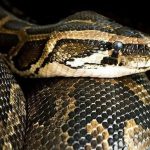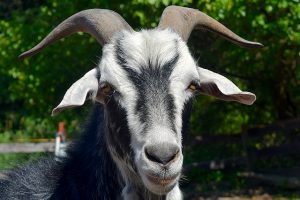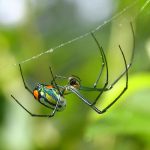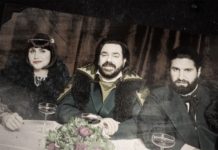Introduction
Life itself is on the brink in the Blade Runner universe, so animals act as a kind of natural mirror for humanity and replicants alike. They connect us to nature, and with each extinction they feel more and more like harbingers of our own extinction. The horror of the biological desolation that humanity caused is only somewhat alleviated by the invention of synthetic animals called animinoids.
But do we already see animals as machines? Or do we see them as family?
If replicants and animinoids are not grown or cloned, are they constructed piece-by-piece? Why unicorn origami? Does that mean Rachel is a “unicorn” and Deckard needs to just go for it? Or does Gaff use animals to mess with someone he knows is an off-limits replicant that he’s required to help?
I’ve been thinking about this stuff since I first heard about that work-print “director’s cut” in the early 90s. That added a good deal to the discussion and rejuvenated the fandom for 1982’s Blade Runner, and we were all able to see an official Ridley Scott approved version in 1997 as one of the first DVDs ever printed.
There have been six versions of that film produced for audiences, (eight if you count studio and preview screenings), and we fans loved the slow perfecting of this sci-fi classic over the years. I doubt Blade Runner 2049 would have been made if everything hadn’t worked out so well.
And then there’s the original novel. I won’t go too deep into it because this education website shmoop seems to already have the most in-depth analysis out there, but “Do Androids Dream of Electric Sheep?” helped inform what I already knew about the animals from the films. Author Phillip K. Dick unpacks his classic themes of existential conflict and paranoia in a religious world that is rapidly dying. There are some character and setting differences, and the movie used several character amalgamations, but the main story is very similar and it is definitely the same world. In fact – P.K. Dick was able to view some of test footage before he died and exclaimed:
“How did you know that this is what it looked like?!”
I recommend the graphic novel version. I’ve only ever read WATCHMEN so I’m not a comic book guy, but I stumbled upon the official graphic novel version of “Do Androids Dream of Electric Sheep?” (not to be confused with the comic version of Blade Runner) and really dug it.

Fashionable Altruism
Animal husbandry is something that the novel elaborates on. In the immediate aftermath of their cataclysm: World War Terminus, humanity united around the altruistic (and practical) idea of extending “the pack” and taking up the responsibility of caring for our animal cousins.
Is it ironic that the only place animals can survive is in the city?
Well eventually the genuine empathy felt by these fine city-folk transformed into opportunistic signalling which unnaturally fueled demand in the markets. Animiniods became a cheaper option as the real thing became more and more scarce. They were a great option for the middle class, and soon became the only option for the top 1% as well. Asking “Is it real?” became very commonplace among animal and animinoid owners, and social status could be gleaned by the rarity of the animal being copied, or the complexity of the animinoid itself when that became the only option.
Thus, animal husbandry quickly became a kind of fashion statement that was divided by economic class and fueled by the Tyrell Corporation’s increasingly clever synthetic constructions.

Blade Runner 2019 (1982) depicted some of this. Animals are around, but if they aren’t food then they are always synthetic. We do still see people eating fish and carrying raccoons around food markets in cages in the 1982 film (covered in the next article), so there is a faint pulse in the city back in 2019.
By Blade Runner 2049, shit is bleak.
A lot can happen in 30 years. Ecosystems have collapsed by 2049 and there isn’t any food anywhere so definitely no more real animals. No synthetic ones either… I guess it’s true what they say about fashion. But we do have synthetic farms to feed everyone, and a new iteration of the Nexus-series replicants continued by Wallace Corp. Agent Gaff is still making his cryptic origami, and Agent Deckard picked up wood carving, so there is plenty to discuss there.

In the end I found that there was so much to unpack that I might as well identify every animal/animinoid/animal reference and now this one-off article has ballooned into a short, three-part series. As the scope changed so did the parameters, so I am including plants, humans, and replicants as “animals” here.
As my list grew, so did my respect for the movies and original source material. Animal life is an essential part of how we view our world. This deep-dive gave me a much greater appreciation for something that I already loved, and I hope to pass some of that appreciation on to you folks.
Let’s start with the obvious.
Animiniods
The Electric Things
Everyone wants to know what is real in the world of Blade Runner. In “Do Androids Dream of Electric Sheep?”, Agent Deckard receives pity when he explains that his goat is actually synthetic. After his electric sheep “died” he had hoped that he could get something real, alas he had to settle on another animinoid.
He hates these things, but by the end of this story he has gained a very different view on what “life” actually is:
The electric things have their lives, too. Paltry as those lives are.
It gets weird. (SPOILERS)
Deckard comes to believe that he is actually the next prophet of Mercerism, the worldwide religion depicted in the novel. It’s a kind of neo-collectivist doctrine of empathy and “working for the greater good” and is often symbolized by a donkey or toad; what the prophet Mercer called “The creatures most important to him.”
And near the end of the story Deckard stumbles upon one of these animals in the same way that Mercer did during his “epiphany” and sort of merges with him… or something. It’s very trippy stuff. Here’s one panel from the event:

The symbolism of the toad is not as clear to me as the hard-working, thankless donkey. Shmoop once again provided a good analysis suggesting that the adaptability toads require to survive a very harsh life is analogous to our own.
So let’s identify these first few animal subjects. The genus and species are clear and common so these scientific names were simple to look up using the Integrated Taxonomic Information System.
I also included the collective noun (group singular) for each animal. Why include collective nouns e.g. “A parliament of owls”? Because it seems poignant to shed some harsh light on the fact that collections of animals don’t really exist anymore… but mostly because I think collective nouns are fun.
- Sheep Ovis aries
“A flock of sheep.”
Deckard hated his electric sheep. Either they are freakishly life-like toasters, or a lame copy of reality. Both concepts are grotesque to him.
- Nubian Goat Capra aegagrus hircus
“A tribe of goats.”
A decent replacement for his sheep, but Deckard wanted the real thing. He does take some comfort in the fact that his wife hates it more than he does.
 Toad Bufonidae sp.
Toad Bufonidae sp.
“A knot of toads.”
Deckard has a change of heart.
Before we go any further here’s a crash course in taxonomic typography:
- A complete species name includes the capitalized first-word Genus followed by the species/subspecies in italic font e.g. Horse Equus caballus.
- Genus with unknown species gets a “sp.” or “spp.”(pl), new species gets “sp. nov.”
- Higher-order classifications like Family and Order are not italicized e.g. Spider Araneae
On to the films:
“Do you like our owl?”
“Is it artificial?”
“Of course it is.”
“Must be expensive…”
“Very.”

The horned owl is the first animal we actually see in the first Blade Runner film, and the only surviving witness to Tyrell’s murder. There could be some symbolism here: Owls have been associated with wisdom in many cultures, perhaps most clearly as an ancient symbol alongside the Moon for the Greek Goddess Athena. Their stoic demeanor adds to this attribution, and many cultures consider the owl to be extremely intelligent and wise simply due to their ability to see and hunt at night.
HORNED OWL Strigiformes Bub
“A Parliament of Owls”
At first I thought this was a Great Horned Owl. I see these all the time but then I looked up the scientific name: Bubo virginianus… virginianus? I live in northern Virginia so I figured that I had to dig a little deeper. It turns out that what we have here in VA is a larger east-coast cousin and sub-species.
Owls are very expensive as Rachel points out. I suspect this is partly due to that whole flying requirement, but the fact that they are extinct in 2019 really drives up the price. Most other animals are a simpler or less desirable animinoid construction.
When Agent Deckard meets the rather well-adjusted NEXUS-6 “Zhora” working as a dancer at The Snake Pit, he asks about her snakes and proceeds to find himself completely charmed by her feminine wiles. Replicant or not, someone in her trade is going to learn a lot about humanity and know how to manipulate.
Then she tries to choke him to death like a boa constrictor… coincidence?
“Is this a real snake?”
“Of course it’s not real. You think I’d be working in a place like this if I could afford a real snake?”
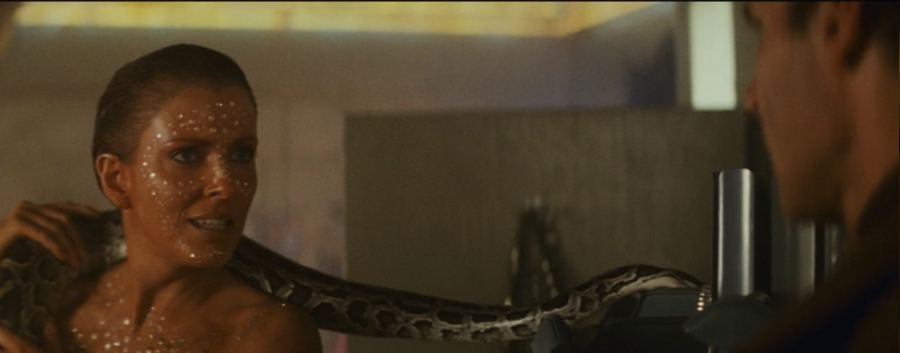
Hey, she seems really nice. I wonder if she’s one of those replicaAWWkK –

“…AWK.. [unintelligible] … ECCHHH ..AWCCHHH…..”
Snake | Boa constrictor
“A knot of snakes”
The real thing can still be bought in 2019 of the Blade Runner universe if you have the money. We see several at the fish market, but those are for eating, no one displays the real thing as decoration. Not even fish.
So here we have a human man and replicant woman looking at a fish tank having their last conversation before kicking off the events depicted in the short film Blade Runner 2022: Black Out. They know that the only way to save the remaining NEXUS-8 series replicants that have not been killed is to destroy all records of their identities and locations.
They want to blend in and disappear, but what they cause has profoundly negative consequences on the remaining plant and animal ecosystems of the world…
 Sturgeonfish Acanthuridae
Sturgeonfish Acanthuridae
“A school of fish”
“Is it real?”
“Of course not.”
“…Just like me.”
“…Are you worried Trixie – ”
“ NO!”
“… Because I’m human?”


The last thing Trixie sees before she dies is a dove… more on that in Part III.
Animals of the Voight-Kampff
Before we ever see Tyrell’s owl or Zhora’s snakes we are asked to imagine a turtle walking through the desert.
In the opening scene of Blade Runner, the renegade NEXUS-6 “Leon” is subjected to the Voight-Kampff test. These tests are all about probing empathy and exposing replicants, so animals provide a pretty good objective baseline for an otherwise subjective concept. Right away we can tell there is something wrong with Leon as Agent Holden sets up the question… Who gives a crap which desert the turtle is walking through?!
So he presses on:
“…You reach down and flip the tortoise on its back, Leon. The tortoise lays on its back, its belly baking in the hot sun beating its legs trying to turn itself over but it can’t – not without your help… But you’re not helping, Leon. Why is that?”
“Whatd’ya mean, I’m not helping?!”
Things do not go well for Agent Holden. His follow-up question is about Leon’s mother and all this replicant has is a shell that dies in 4 years… TRIGGERED.
- Desert Tortoise | Gopherus agassizii and Gopherus morafkai
- “A bale of turtles.”
Conversely, the Prototype NEXUS-7, “Rachel” is armed with memories and a belief that she is real. She sits down with Deckard to take the test and at first she’s doing great, even if her answers sound canned. But over time her impatience and frustration slowly expose her true nature.
“It’s your birthday… Someone gives you a calfskin wallet.”

“I wouldn’t accept it. Also, I’d report the person who gave it to me to the police.”
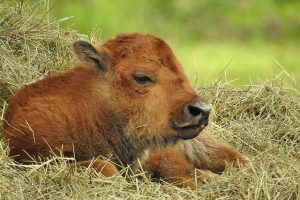 CALF Bovinae sp.
CALF Bovinae sp.
“A herd of cows.”
A “calfskin wallet” could refer to many different animal youths in the Bovine family, but domestic cattle is much more likely than yak or bison.
“You’ve got a little boy… he shows you his butterfly collection, plus the killing-jar”
“I’d take him to the doctor.”
 BUTTERFLY Rhopalocera spp.
BUTTERFLY Rhopalocera spp.
“A flight of butterflies.”
These insects are as fragile as they look. Break a wing and it dies.
“You’re watching television… Suddenly you realize there’s a wasp crawling on your arm.”
“I’d kill it.”
 WASP Vespula
WASP Vespula
“A nest of wasps”
All hornets are wasps, and some wasps are hornets.
“You’re watching a stage-play, a banquet is in progress. The guests are enjoying an appetizer of raw oysters…”

OYSTER Crassostrea
“A bed of oysters.”
Looks delicious.
All of these questions themselves present a glimpse into these first years following the Cataclysm. Oysters are still around but seafood gets old after awhile.
“… the entree consists of boiled dog.”

BOILED DOG Canis familiaris
“A pack of dogs”
Apparently we started eating our easy-to-catch canine friends after 32,000 years of cooperation. I guess we didn’t need them for hunting because everything is dead. Sad.
Rachel does well though.
Memories were designed to help her develop healthy life/death perspectives. Second-hand memories of childhood sexual experimentation, shame, fear and empathy with a little context prepared Rachel for this emotional bombardment. I still think lying to her about what she was is actually pretty fucked up… but I get it.
So whatever fragile foundation she had remaining after her Voight-Kampff test takes a knee to the face later that evening in Deckard’s apartment:
“You remember the spider that lived in a bush outside your window? Orange body, green legs? Watched her build a web all summer? Then one day there was a big egg in it. The egg hatched – ”
“The egg hatched… and a hundred baby spiders came out… and they ate her.”
There it is: Life/Death and the horrible beauty of it all. Moreover, this story of The Mother and her children actually manifests in Blade Runner 2049.
I‘m sure that Rachel thought about it often, particularly near the end…

Curiously, if you listen closely to an earlier time-lapse fade during Rachel’s Voight-Kampff test, you can hear Deckard say the exact same line about the spider. It sounds like the same take. Perhaps this is meant to mess with the viewer’s own sense of memory because it could not have been part of the test.
 VENUSTA ORCHARD ORB-WEAVER Leucauge venusta
VENUSTA ORCHARD ORB-WEAVER Leucauge venusta
“A Cluster of Spiders”
This was one of the first cases I investigated. We know that it has an orange body with green legs which is great because that particular description is rare.
A crab spider (Diaea dorsata) looked promising, but is way too small and doesn’t make webs. The only other option turned out to be that Venusta Orchard Orb-Weaver. If you are a spider expert with a better suggestion – leave a comment below!
Come back in a few days for PART II of the Animals of Blade Runner and we’ll wade into the fish markets of 2019, pick through the “food” situation in 2049, and ponder bees.
-IDH
Do Androids Dream of Electric Sheep?
By Philip K. Dick
Blade Runner
Screenplay written by Hampton Fancher and David Peoples
Directed by Ridley Scott
Blade Runner Black Out 2022
Written and directed by Shinichiro Watanabe
Blade Runner 2036: Nexus Dawn
Written by Hampton Fancher and Michael Green
Directed by Luke Scott
Blade Runner 2049
Written by Hampton Fancher and Michael Green
Directed by Denis Villeneuve
Other Sources
https://pixabay.com
http://bladerunner.wikia.com
https://www.insectidentification.org/
http://louisianabelleforever.blogspot.com
https://www.shmoop.com/do-androids-dream-of-electric-sheep/
http://animal-world.com/encyclo/marine/tangs/caribblue.php
https://en.wikipedia.org/wiki/Fish#Taxonomy
[amazon_link asins=’0345404475,1608865002,1608865096,1608865770,1608866157,1608866408,1608866416,B004FQX5CK,B075DHS7JK,0140170960′ template=’ProductCarousel’ store=’filmgoblin-20′ marketplace=’US’ link_id=’4a923954-575a-11e8-a0ca-c722f9ad72cc’]



